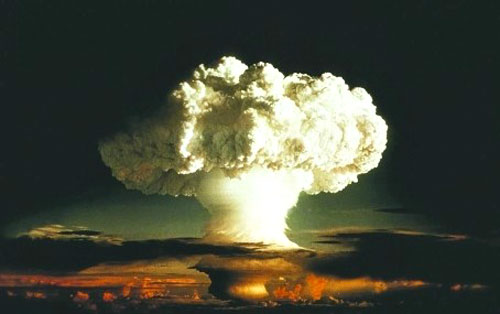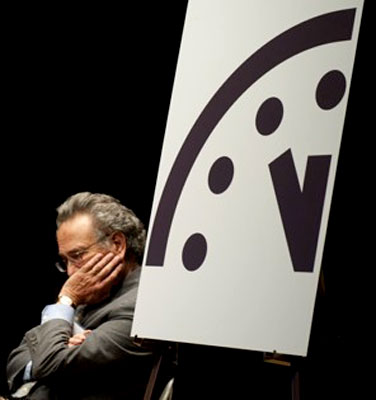|
January 10, 2012
The mushroom cloud of the first test of a hydrogen bomb, “Ivy Mike,” as photographed on Enewetak, an atoll in the Pacific Ocean, in 1952. (U.S. Air Force via Reuters)
By at least one
measure, the world just got that much closer to apocalypse. The Doomsday Clock, a figurative timepiece used as a barometer of humankind’s fate, was moved one minute closer to midnight on Tuesday, the first time it has been nudged forward since 2007.
It is now 11:55, five minutes before the
appointed hour.
The setting of the clock is no longer
based only on the proliferation of nuclear arms, but also on threats
such as climate change and biological weaponry.
Just two years ago, following global talks on climate change in Copenhagen and international pledges to reduce nuclear stockpiles, the BAS moved the clock backward by a minute.
and a member of the Bulletin of the Atomic Scientists, during an event announcing a reset of the Doomsday Clock. (Saul Loeb - Getty Images)
Since being unveiled in 1947, the clock has been reset 20 times.
It came closest to doomsday in 1953,
when the start of the nuclear arms race pushed its hand to two
minutes to midnight, and moved the farthest away in 1991, when the
signing of the Strategic Arms Reduction Treaty (START) by the United
States and the Soviet Union gave the world 17 minutes until
midnight.
The United States and other major powers have not yet ratified the Comprehensive Test Ban Treaty.
There has also been little progress on a treaty that would prohibit further production of fissile material for nuclear weapons.
BAS said not all news was bad over the
past year. The group’s members say they were heartened by the Arab
Spring, the Occupy movements and political protest in Russia.
|


